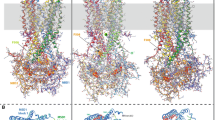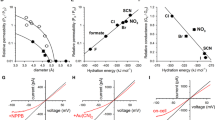Abstract
Members of the ABC transporter superfamily contain two nucleotide binding domains. To date, the three dimensional structure of no member of this super-family has been elucidated. To gain structural insight, the known structures of several other nucleotides binding proteins can be used as a framework for modeling these domains. We have modeled both nucleotide binding domains of the protein CFTR (Cystic Fibrosis Transmembrane Conductance Regulator) using the two similar domains of mitochondrial F1-ATPase. The models obtained, provide useful insights into the putative functions of these domains and their possible interaction as well as a rationale for the basis of Cystic Fibrosis causing mutations. First, the two nucleotide binding domains (folds) of CFTR are each predicted to span a 240–250 amino acid sequence rather than the 150–160 amino acid sequence originally proposed. Second, the first nucleotide binding fold, is predicted to catalyze significant rates of ATP hydrolysis as a catalytic base (E504) resides near the γ phosphate of ATP. This prediction has been verified experimentally [Ko, Y.H., and Pedersen, P.L. (1995) J. Biol. Chem. 268, 24330-24338], providing support for the model. In contrast, the second nucleotide binding fold is predicted at best to be a weak ATPase as the glutamic acid residue is replaced with a glutamine. Third, F508, which when deleted causes ∼70% of all cases of cystic fibrosis, is predicted to lie in a cleft near the nucleotide binding pocket. All other disease causing mutations within the two nucleotide binding domains of CFTR either reside near the Walker A and Walker B consensus motifs in the heart of the nucleotide binding pocket, or in the C motif which lies outside but near the nucleotide binding pocket. Finally, the two nucleotide binding domains of CFTR are predicted to interact, and in one of the two predicted orientations, F508 resides near the interface.
This is the first report where both nucleotide binding domains of an ABC transporter and their putative domain-domain interactions have been modeled in three dimensions. The methods and the template used in this work can be used to analyze the structures and function of the nucleotide binding domains of all other members of the ABC transporter super-family.
Similar content being viewed by others
REFERENCES
Annereau J.P., Wulbrand U., Vankeerberghen A., Cuppens H., Bontems F., Tummler B., Cassiman J.J. and Stoven V. (1997) FEBS Lett. 407, 303–308.
Abrahams J.P., Leslie A.G.W., Lutter R. and Walker J.E. (1994) Nature 370, 621–628.
Bianchet M.A., Hullihen J., Pedersen P.L. and Amzel L.M. (1998) In Review.
Bianchet M., Ko Y.H. and Pedersen P.L. (1995a) Ped. Pulmon. Suppl. 12, abstract 32.
Bianchet M.A., Ko Y.H., Amzel L.M., Pedersen P.L. (1995b) Biophysical J. 70(2):A214.
Carson M.R., Travis S.M. and Welsh M.J. (1995a) J. Biol. Chem. 270(4):1711–1717.
Carson M.R., Travis S.M. and Welsh M.J. (1995b) Biophysical J. 69, 2443–2448.
Cheng S.H., Gregory R.J., Marshall J., Paul S., Souza D.W., White G.A., O'Riordan C.R. and Smith A.E. (1990) Cell 63, 827–829.
Cheng S.H., Rich D.P., Marshall J., Gregory R.J., Welsh M.J., Smith A.E. (1991) Cell 66, 1027–1036.
Chou P.Y. and Fasman G.D. (1978) Adv. Enzymol. 47, 45–148.
Denning G.M., Ostergard L.S., Cheng S.H., Smith A.E. and Welsh M.J. (1992) J. Clin. Invest. 89, 339–349.
Dalemans W., Barbry P., Champigny G., Jallat S., Dott K., Dreyer D., Crystal R.G., Pavirani A., Lecocq J.P. and Lazduski M. (1991) Nature 354, 526–528.
Doige C.A. and Ames G.F-L. (1993) Annu. Rev. Microbiol. 47, 291–319.
Evans S.V. (1993) J. Mol. Graphics 11, 134–138.
Higgins C.F. (1992) Annu. Rev. Cell Biol. 267, 6455–6458.
Hyde S.C., P. Emsley, M.J. Harsthorn, M.M. Mimmack, U. Gileadi, S.R. Pearce, R.E. Hubbard & C.F. Higgins. (1990) Nature 346, 362–365.
Kerem E., Corey M., Kerem B.S., Rommens J., Manneweiz D., Kobayashi K., Knowles M.R., Boucher R.C., O'Brien W.E., Beaudet A.L. (1990) J. Hum. Genet. 110, 599–605.
Ko Y.H. and Pedersen P.L. ( 1995) J. Biol. Chem. 268, 24330–24338.
Ko Y.H., Thomas P.J. and Pedersen P.L. (1994) J. Biol Chem. 269, 14584–14588.
Ko Y.H., Delannoy M. and Pedersen P.L. (1997) Biochem. 36, 5053–5064.
Levison H., Tsui L.C., Durie P. (1990) N Engl. J. Med. 323, 1517–1522.
Li C.H., Ramjeesingh Wang W., Garami E., Hewryk M., Lee D., Rommens J.M., Galley K., Bear C.E. (1996) J. Biol. Chem. 271, 28463–28468.
Manavalan P., Dearborn D.G., McPherson J.M. and Smith A.E. (1995) FEBS Lett. 366, 87–91.
Morikawa K., la Cour T.F., Nyborg J., Rasmussen K.M., Miller D.L., Clark B.F. (1978) J. Mol. Biol. 5;125, 325–338.
Nicholls A., Sharp K. and Honig B. (1991) PROTEINS: Structure, Function and Genetics, 11, 281–296.
Noel J.P., Hamm H.E., Sigler P.B. (1993) Nature, 366, 654–663.
Pai E.F., Krengel U., Petsko G.A., Goody R.S., Kabsch W., Wittinghofer A. (1990) EMBO J., 9, 2351–2359.
Pedersen P.L. and Amzel L.M. (1993) J. Biol. Chem. 268, 9937–9940.
Qu B-H. and Thomas P. (1996) J. Biol. Chem. 271, 7261–7264.
Riordan J.R., Rommens J.M., Kerem B., Alon N., Rozmahel R., Grzelczak Z., Zielenski J., Lok S., Plavsic N., Chou J., Drumm M.L., Iannuzzi C., Collins F.S. and Tsui L. (1989) Science 245, 1066–1073.
Rich D.P., Anderson M.P., Gregory R.J., Cheng S.H., Paul S., Jefferson D.M., McCann J.D., Klinger K.W., Smith A. and Welsh M.J. (1991) Nature 347, 358–363.
Rossmann M.G., Moras D. and Olsen K.W. (1974) Nature 250, 194–199.
Rost B. (1996) Meth. in Enzym. 266, 525–539.
Saraste M., Sibbald P.R. and Wittinghofer A. (1990) Trends in Biochem. Sci. 15, 430–434.
Shirakihara Y., Leslie A., Abrahams J.P., Walker J., Ueda T., Sekimoto Y., Kambara M., Saiga K., Odaka M., Yoshida M. and Kagawa Y. (1997) Structure 5, 825–836.
Story R.M., Weber I.T., Steitz T.A. (1992) Nature 355, 567.
Schulz G.E., Elzinga M., Marx F., Schrimer R.H. (1974) Nature 250, 120–123.
Taylor W.R. and Green N.M. (1989) FEBS 179, 241–248.
Teem J.L., Berger L.S., Ostedgaard D.P., Rich D.P., Tsui L-C. and Welsh M.J. (1993) Cell 73, 335–346.
Thomas P.J., Pedersen P.L. (1993) J. Bioener. & Biomem. 25:11–20.
Tsui L-C. (1992) Trends of Genetics 8, 392–398.
Walker J.E., Saraste M., Runswick M.J. and Gay N.J. (1982) EMBO J. 1, 945–951.
Weber J. and Senior A.E. (1997) Biochem. Biophys. Acta 1319, 19–58.
White S. (1994) Ed. S. White, Oxford University Press, New York, 97–124.
Yu X., Egelman E.H. (1997) Nat. Struct. Biol. 4, 101.
Author information
Authors and Affiliations
Rights and permissions
About this article
Cite this article
Bianchet, M.A., Ko, Y.H., Amzel, L.M. et al. Modeling of Nucleotide Binding Domains of ABC Transporter Proteins Based on a F1-ATPase/recA Topology: Structural Model of the Nucleotide Binding Domains of the Cystic Fibrosis Transmembrane Conductance Regulator (CFTR). J Bioenerg Biomembr 29, 503–524 (1997). https://doi.org/10.1023/A:1022443209010
Issue Date:
DOI: https://doi.org/10.1023/A:1022443209010




